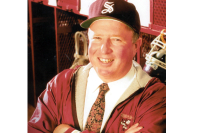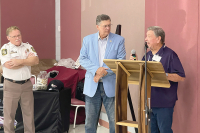Finding real news is just not that hard

National Public Lands Day dawned crisp and cool Saturday, Sept. 24, a celebration of everything most beloved about fall in Western North Carolina — sunrise pinks and oranges streaking the skies above the ridgeline; clear, dry air carrying an invigorating early-morning chill; bright sunshine focusing the world beneath warm rays as the sky brightened, revealing mountainsides tinged with hints of red and yellow, rogue branches overly eager for the autumnal wardrobe change.
— Even in this fast-paced business of journalism, the good ones can make the words sparkle. This is the opening of a report in last week’s Smoky Mountain News from our award-winning outdoors writer Holly Kays on the celebration of National Public Lands Day. Savor the imagery.
This is National Newspaper Week, a few days set aside to celebrate what’s been described as “one of the most successful consumer products of all time. What else has sold for pennies for much of three centuries, with a majority of the public making use of it?” (Hell, sometimes they are even free!)
The description above comes from Ken Paulson, the director of the non-partisan Free Speech Center at Middle Tennessee State University (freespeech.center).
In a recent essay, Paulson expounded on the relevance of newspapers and the work of their reporters:
The scope of newspaper reporting worldwide remains astonishing. Yes, broadcast and cable networks, magazines, large news websites, local television and radio all do some original reporting. But that coverage pales by comparison to what is generated by newspaper newsrooms.
Related Items
The majority of news you see reported, cited or transformed into a meme began in a newspaper newsroom. Major newspapers like The New York Times, Washington Post, Wall Street Journal and USA Today share coverage globally, but thousands of smaller papers do the same by sharing their news articles with the world via the Associated Press.
Skeptical? I suggest that you pull out your phone or — for irony’s sake — a piece of paper, and watch tonight’s local TV newscast. Tune into a local radio station for its five minutes of news. Tally the total number of stories and see how many actually involve reporting by the station’s newsroom. How many stories just sound like they were pulled from a newspaper? They may well have been. Then hop on to your Facebook or Twitter feed and see how many posts link to newspaper articles. If they link to other media, click to see where those outlets got their information.
Why are other media so dependent on newspapers? Because they always have been. Veteran broadcast journalists will tell you that newspapers have long acted as a tip sheet. Find an interesting local story in the paper, and then try to tell the story in a more compelling way with video and audio. Even newsrooms that have faced staffing reductions typically still have twice the resources of their broadcast rivals.
Many of you may remember Russ Bowman, a former WLOS reporter who was one of the better ones to ever work there. Many Wednesday mornings we would be sipping coffee at our former office Church Street and Bowman would walk in with a fresh copy of The Smoky Mountain News, straight up telling us that he was going to re-do one of our stories for his mid-day report. He was a colleague and a friend, but he also rode the coattails of our reporting for some of his broadcasts. That’s just how the journalism food chain works. All good.
So when you think about newspapers today, really you can leave out the “paper” bit. Sure, there’s some like me, who still prefer the tactile experience of holding, turning pages, folding, leaning in, turning on the reading lamp, tossing the paper to your spouse to read a particular story. But it’s the reporting, the adherence to professional standards that sets us apart from other types of media.
Here’s something I come across often. Many people can explain in great detail why this country is so divided when it comes to political ideology but don’t know which county commissioners want to spend more money on public schools, what the town planning board just did, or when you can start voting? Well, guess what? That’s the what the local newspaper is for, whether you absorb the information in print or online.
So if you want to know what’s happening in the place you call home, keep reading. Sometimes, you’ll even be treated to something resembling poetry from writers at the top of their game.
(Scott McLeod can be reached at This email address is being protected from spambots. You need JavaScript enabled to view it..)













